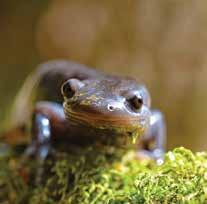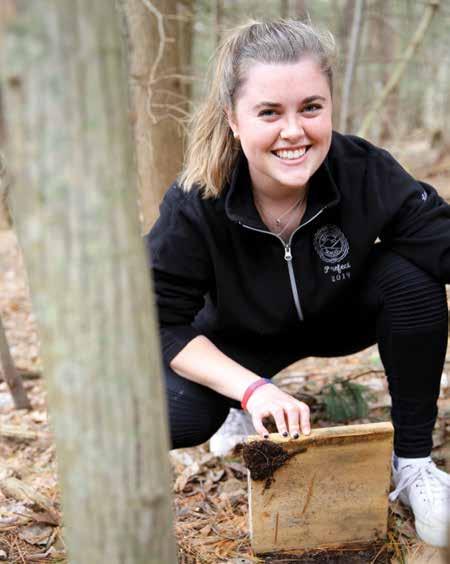
8 minute read
REBUILDING HISTORY
The Rededication of Chevalier Senior Lodge
by Hannah Van Sickle
Advertisement
The Berkshire community, the Board of Trustees, and friends of the School gathered under the Mountain on September 28, 2018, for the rededication of the Chevalier Senior Lodge named in memory of Stephanie Y. Chevalier ’77.
The Chevalier Senior Lodge, formerly known as the “faculty shack” or “Coffee House,” was rebuilt in the summer of 2018, in its exact location, after the 90-year-old structure deteriorated beyond simple repair. “Thanks to generous contributions by Trustees Emeriti Peter Kellogg ’61 and Hugh Knowlton (Stephanie’s father) and other gifts, the Lodge has been restored to its former glory with an eye toward its original elements,” said Head of School Pieter Mulder in his remarks at the rededication.
The space continues to honor “a living
memorial suitable to the fun-loving, giving spirit that is the Stephanie [so many] remember.” 1 The structure was first dedicated to Stephanie in October 1978 after she was killed in a tragic automobile accident shortly after her graduation from Berkshire. The School took meticulous efforts to replicate the original structure from the 1930s. In Mulder’s remarks, he cited the “faithful efforts” of Director of Facilities Management Tim Fulco ’78 as instrumental in returning the spirit of the structure to its rightful place on campus. Fulco, who spearheaded the construction project, points to the

In memory of Stephanie Chevalier ’77, the 1978 senior class launched a fund drive to convert the Coffee House to a Senior Lodge. The funds were used to refurbish the interior, rebuild the chimney, and fix the wall paneling.
The Chevalier Senior Lodge serves as a tech-free, place-based classroom to support the School’s environmental science and sustainability courses.
community’s shared vision: “The goal for this replica was to utilize natural materials such as wood, stone, and steel in an effort to replicate the materials available at the time of its original construction.” In a fitting tribute to the School’s history, the restoration hinged on historical details, as Fulco and his team gleaned vintage lighting fixtures from the hallways and dining room of Memorial Hall; refurbished the wood stove and returned it to its place of prominence on the hearth; and tracked down the manufacturer of the original siding, all in an effort to retain the authentic aesthetic.
While the Lodge has been updated, it still bears tributes to Stephanie, including a commemorative plaque inscribed with a quote from Stephanie’s classmate, Dr. Amy Waldo Allen ’77: “Stephanie showed us that it is not the length of one’s life that is important but the quality of it.” Also on display is a framed tribute to Stephanie and an 1884 “crazy quilt” donated by Monique Knowlton (Stephanie’s mother). During the rededication, Allen recalled her friend as “refreshingly different,” noting that Stephanie was “sophisticated beyond her years.” She drew attention to Stephanie’s greatest attribute, calling her “a good and beautiful and unforgettable friend that

From left: Board of Trustees Chair Chip Perkins ’73, P’14,’14, Emily Hunsicker P’11, Dr. Amy Waldo Allen ’77, Trustee David Rondeau ’78, and Head of School Pieter Mulder P’22 [she feels] blessed to have known.”
Over the decades, the Lodge has served a variety of purposes for our community. Thanks to research undertaken by former Berkshire English teacher and Department Chair Hilary Russell, we have learned that the Lodge has been: a place for students to congregate after athletic contests and before dinner; a meeting place for members of The Green and Gray and the Trail Squad; a home to the Watch programs, with activities that included hiking, studying nature, maintaining trails, and drying and mounting wildflowers and leaves; and, a location for students to design and build rustic chairs and tables in a winter furniture-building course. Most recently, the Lodge housed the Boat Building Program, where students practiced primarily skin-on-frame construction to build double paddle canoes, kayaks, umiaks, sculls, surfboards, paddle boards, and even a skateboard. Today, the Chevalier Senior Lodge serves as a tech-free, place-based classroom to support the School’s environmental science and sustainability courses. “Teaching and learning out of Chevalier has been a dream,” shares Cait Ward ’08, who teaches Advanced Environmental Science Research—a new yearlong course designed for students who are interested in applying their environmental science knowledge through
Stephanie Y. Chevalier ’77, for whom the Chevalier Senior Lodge is named


a local exploration of Berkshire’s 400 acres of land. The space also supports Berkshire’s strategic priorities, which aim to embed in the curriculum “place-based educational experiences that utilize the Mountain and our unique setting.”
And while the Chevalier Senior Lodge honors history—both the School’s and Stephanie’s—it ushers in a new wave of students and an innovative approach to teaching science, all in keeping with what student Board of Directors President Gib Amber ’78 said of Stephanie in a 1978 article by David Rondeau ’78 in The Green and Gray: “This lodge will help to perpetuate a feeling of sharing and companionship in a community atmosphere that Stephanie did so much to foster during her Berkshire days.” To read more about the new Advanced Environmental Science Research course, see page 6.
DIGGING FOR ANSWERS
Students explore real-world ecological issues in the new Advanced Environmental Science Research class.
by Hannah Van Sickle

The Jefferson salamander has a lot on its small shoulders: it regulates the food chain to ensure a vibrant ecosystem. If the population of Jefferson salamanders is faltering, the environment might be, too. Sophie Reed ’19 wondered: How were the Jefferson salamanders that lived at the base of the Mountain faring? She decided to investigate further.
Reed was one of 18 students enrolled in Berkshire’s new yearlong Advanced Environmental Science Research (AESR) course, housed in a tech-free classroom in the rededicated Chevalier Senior Lodge. Students chose a research project—in Reed’s case, the salamanders—and pursued answers to real-world ecological issues.
“It was a bit daunting at first,” Reed says of her endeavor to track the species’ population density in its rural habitat. Despite the Jefferson salamanders living in close proximity to healthy vernal pools behind East Campus, she feared the community knew little about the species. This, coupled with the fact that salamanders are unpredictable, quickly gave shape to Reed’s research. “I became interested in the ways in which our school community affects the species near us, and I learned so much this year.”
At the helm of AESR is teacher Cait Ward ’08, who says the curriculum allows students to apply knowledge they gained in AP Environmental
Sophie Reed ’19 studying endangered Jefferson salamanders here in Sheffield
Science to potentially advance science
P h o t o b y D o m S a y l e r

Jefferson salamander is a mole salamander that spends larger amounts of time underground than other breeds. They can be seen above ground during the mating season, which takes places in early spring.

AESR teacher Cait Ward ’08 works with Jeff McKee ’19 and Kat Erazo ’19 in the Chevalier Senior Lodge.
or implement sustainability measures as they uncover answers to their questions. For example, Reed is in the process of lobbying the state of Massachusetts to legally protect the vernal pools on campus, where the salamanders breed year after year.
Ward also credited the Chevalier Senior Lodge, which is nestled in a grove of pine trees on campus, for evoking a sustainability mindset. “Teaching and learning out of Chevalier this fall has been a dream,” Ward wrote in a letter commemorating the building’s rededication. “Walking through the pines [to class] has quickly become the highlight of my day, as the journey through the forest immediately sets the stage for conversations around environmental stewardship, ecological sustainability, and technology.”
Science Department Chair Dr. April Burch shares Ward’s enthusiasm for AESR, calling it “a class that will support advanced research opportunities for students who are passionate about ecology, environmental stewardship, and social justice issues related to environmental science.”
Burch continues: “It has been so exciting to see Cait bring her vision for high-level environmental research to life with this new offering. She has created a truly unique educational experience for students, one that I’m sure they will hold fondly.”
Ward is specifically encouraging her students to focus their research on topics related to the Mountain, which aligns with the School’s strategic priority to “incorporate the Mountain more fluidly into our classes.” AESR, Ward says, has provided tangible access to the Mountain in both a physical and a spiritual sense, and many students have begun to “build familiarity with the physical space and recognize the importance of these surroundings to their research.”
Carter Allen ’19’s interest in climate change inspired him to enroll in the class and learn more about protecting the local ecosystem. In his pursuit, he asked: What factors make the ecosystems surrounding Berkshire School unique? Allen made clear his dual intent: “To bring more awareness to the Mountain and hopefully inspire people to spend more time on it.”
Allen enjoyed both the challenge and the independence of the class. “Not only do we get to completely choose what we are going to study, but we choose our progression and our guidelines; it’s been very rewarding,” he says.
And then there is the teacher: “If you are eager and wanting to learn, Ms. Ward will do everything to help you succeed,” says Annabel Pirkle ’19, who studied the effects of climate change on sugar maple trees. Her classmates describe Ward as equally passionate about the environment and their own success.
Most importantly, Ward wants her students to develop a personal accountability to the environment. “We talk a lot about what it means to be a responsible human, one who is rooted in obligation to caring for their surroundings,” she says. This then provides a foundation for what Ward calls “diving in to environmental issues and policy in a different way—one that connects to students’ other classes” and creates a firm connection to the very environment in which they both live and learn.
To read students’ AESR Independent Projects, go to http://bit.ly/AESRprojects.




